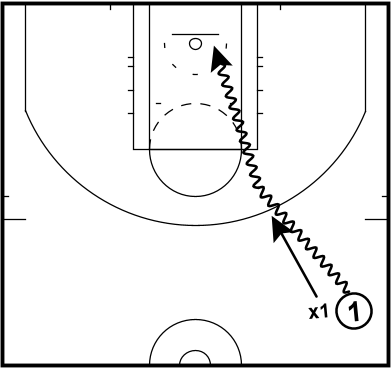How One Of The Slowest Players In The NBA Gets Past Elite 1 on 1 Defenders
No one would say that Luka Doncic is one of the quickest players in the NBA. However, his ability to accelerate and decelerate is elite.
Because he is always changing speeds, he becomes much harder to guard. It's why he's possibly the best 1 v 1 offensive player in the NBA.
His defender is always having to react to a changing pace. That is much harder than guarding someone who is always going the same speed, even if that speed is fast.
I've seen this first hand.
Matt was one of the quickest players I've ever coached. When you watched him in drills, you were convinced no one would be able to stay in front of him.
Ray was moderately quick. If you watch him in drills, he didn't jump off the page.
Something weird happened when games started. Matt could almost never create space with his dribble. Ray almost always did.
Why? A simple reason - Matt always played at one speed, while Ray was great at changing speeds.
What Basketball Players Can Learn From Pitchers
In the history of Major League Baseball, there have been a lot of guys who throw in the mid to high 90's. Some succeed, some don't.
One of the differentiators is that most of the guys who succeed have more than just one pitch.
No matter how hard you throw, if it's the same speed every time, hitters will adjust.
However, if you can throw hard AND you have a good off speed pitch, you make yourself much harder to hit.
The same applies in basketball.
Train this skill to make yourself quicker and harder to guard!
FREE BONUS VIDEO
3 Individual Skills Workout
2 Simple Dribbling Drills to Master Changing Speeds
Changing speeds can and should be practiced. Here are some ways to develop this valuable skill.
- Starts and Stops- Start on the baseline. Take 1 hard pound dribble in place, followed by a pushout dribble.
- Zig Zag Speed Change-Start on the baseline. Begin by taking 2-3 dribbles with your right hand going at an angle to your right. When going right, go at full speed.
When you make your pushout dribble, you want to fully extend your arm in front of you. This means your elbow should be locked out. This allows you to push the ball out farther in front of you.
On the pushout dribble, sprint and cover as much ground as possible.
After the pushout, decelerate to a stop while maintaining your dribble. Take 2-3 pound dribbles in place. Then perform another pushout dribble and cover as much ground as possible.
Stop and perform a couple pounds dribbles and repeat. Continue this pattern all the way down the floor, working on accelerating and decelerating.
Make sure to perform the drill with both hands.
After 2-3 dribbles, perform a change of direction move to switch the ball to your left hand. Take 2-3 dribbles going left at 50% speed.
Then after another 2-3 dribbles, change hands and direction back to your right and go full speed again.
Continue the length of the floor, alternating hands and speeds. On the way back, go full speed with your left hand and half speed with your right hand.
Here's an example of the Zig Zag speed change dribbling drills.
Unique 1v1 Drill To Master Speed Variation in Real Time
Once you've drilled changing speeds, try it in competition. A great way to do so is with Walk to Run 1v1.
- Start with the offense and defense standing next to each other. The offense has a ball.
The offense begins to dribble and walk towards the rim.
At some point, the offense will accelerate to full speed and attempt to score. The defense does not know when this will happen.
The offensive player's goal is to create space and advantage when they change speeds. The defense will work on recovery and contesting.
Here's an example of Walk To Run 1v1. In this example, the defense is holding a ball. This gives the offense more of an advantage.
After you've have had a chance to do this, make it Run to Walk to Run 1v1.
- This is almost the same drill. The only difference is the offense starts running.
At some point, they then decelerate to a walk.
Finally, they accelerate again to a run and attempt to finish.
How to Prevent Defensive Recovery Off Your Acceleration
In the 1v1 drills, you are watching to see how well your players change speeds. One additional coaching point is to teach them to take away the defense's recovery angle.
Too many players attack wide, allowing the defense to recover and negate the advantage the offense worked to establish.

To practice this, encourage the offense to get into the defender's path when they make their pushout dribble.
In doing so, they put the defender behind them, making it hard for the defense to get back in the play.
The Key Difference Between Being Quick and Playing Quick
Being quick is largely a gift. Playing quick is a skill.
And the great news is you can play quicker without getting quicker.
By learning to change speeds, you'll make yourself harder to guard.
Get after it!
FREE BONUS VIDEO
3 Individual Skills Workout
What do you think? Let us know by leaving your comments, suggestions, and questions...
|
|||||



 Facebook (145k Followers)
Facebook (145k Followers) YouTube (152k Subscribers)
YouTube (152k Subscribers) Twitter (33k Followers)
Twitter (33k Followers) Q&A Forum
Q&A Forum Podcasts
Podcasts